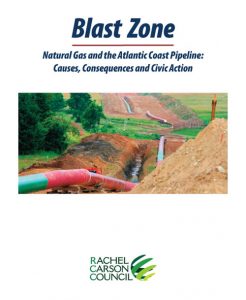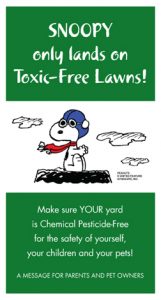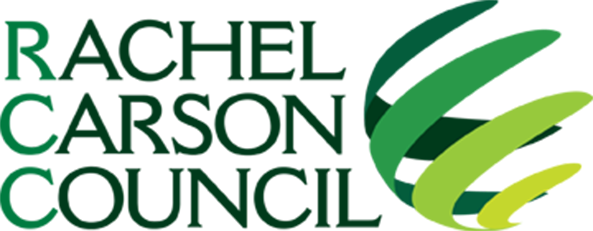Publications
 Tides Up
Tides Up
Tides Up: Nature-Based Solutions for Sea Level Rise is a first-of-its kind report from the RCC detailing the threats facing coastal communities, the long-term benefits of nature-based solutions (NBS), and the socioeconomic implications of these efforts. Tides Up grows out of the RCC’s mission to continue for contemporary times the legacy of marine biologist and renowned nature writer, Rachel Carson. Carson wrote the 1951 bestseller and U.S. National Book Award winner The Sea Around Us, as well as two other two books in her sea trilogy, The Edge of the Sea, and Under the Sea-Wind. Renowned for Silent Spring, her exposé of DDT and other pesticides that ignited the modern environmental movement, Rachel Carson was also an esteemed coastal conservationist. By exploring how to restore and enhance coastlines to their full potential, especially in a time of climate crisis, Tides Up carries on her vision.
 Swine and Suffering
Swine and Suffering
Swine and Suffering: An Introduction to the Hidden Harms of Factory Farms is the third report by the Rachel Carson Council calling attention to the environmental and health hazards of factory farms, or CAFOs, especially hog CAFOs and their overwhelming concentration in just a few small areas of the United States – Iowa, Minnesota, and North Carolina. Swine and Suffering is designed as a simple, useful short introduction for a new generation who, like those who have gone before, know little about where their food, especially their meat, comes from, or the consequences of its industrial scale production for their lives. CAFOs are a major source of air and water pollution, methane emissions causing global climate change, and an environmental justice health hazard to poor communities of color who live near them.
Click here for Swine and Suffering PDF.
 Greenwashing
Greenwashing
Greenwashing: A Report on the Corporate Selling of Polluting Wood Pellet Production is the Rachel Carson Council’s (RCC) third comprehensive report exposing the wood pellet industry, following Clear Cut and Bad Business which respectively explore the “forces driving the wood pellet industry’s hold in the United States” and the “money behind the wood pellet industry.” Each report in the series discusses the severe environmental and climate damage caused by wood pellet production in the United States (U.S.).
But Greenwashing offers a new perspective, shedding light on the deceptive claims made by and misinformation surrounding the industry that has increased wood pellet production while preventing real progress on energy justice.
Click here for Greenwashing PDF.
 Money Talks: Strategy, Success, and Action on Divesting and Reinvesting Funds for Fossil Fuels
Money Talks: Strategy, Success, and Action on Divesting and Reinvesting Funds for Fossil Fuels
Rachel Carson understood that money talks. She would have welcomed the successes of today’s fossil fuel divestment campaigns and their careful dissection of the evasions and prevarications of the oil, gas, and coal industries and the disastrous effect of their products on the planet and on human health. And she would have been heartened by the leading role of young Americans on college campuses in calling these companies to account, in demanding that colleges and universities live up to their professed ideals by eliminating their investments in fossil fuel companies and refusing to accept contributions from them. It is why the Rachel Carson Council, the organization that Carson wanted her friends to initiate to carry on after her death, has published this comprehensive report, Money Talks: Strategy, Success, and Action on Divesting and Reinvesting Funds for Fossil Fuels.
Click here for Money Talks PDF.
 Bad Business: RCC Report Reveals Failing Future for Wood Pellet Industry
Bad Business: RCC Report Reveals Failing Future for Wood Pellet Industry
The Rachel Carson Council’s report, Bad Business, takes a detailed look at the money behind the wood pellet industry that is clear-cutting America’s forests and producing pollution and climate change. In this powerful sequel to Clear Cut, the RCC’s widely praised exposé of the damage and injustices caused by wood pellet production, Bad Business shows that the growing, but little understood, woody biomass energy industry is propped up by mistaken counting rules and a host of subsidies, credits, and tax incentives. Woody biomass energy also burdens rate and taxpayers with additional costs through its destruction of natural forests that filter the air and water, prevent run-off and flooding, and absorb greenhouse gases.
Bad Business decisively describes how wood pellet production is neither renewable, carbon neutral, nor cost competitive through a close comparison with truly renewable energy sources like wind and solar.
This breakthrough report concludes with a series of carefully designed policies and actions that citizens, policy makers and investors alike can take in order to move toward a just, sustainable future and put an end to an energy source that is destroying forests, communities and the planet.
Click here for Bad Business PDF.
 Clear Cut: RCC Report about Wood Pellets, Enviva, and Environmental Justice
Clear Cut: RCC Report about Wood Pellets, Enviva, and Environmental Justice
The Rachel Carson Council’s new report, Clear Cut, takes a comprehensive look at the forces driving the wood pellet industry’s hold in the United States. Industrial-scale wood pellets have been globally touted as a ‘green’ technology to lessen dependence on fossil fuels. However, burning wood pellets is worse for climate change than coal, one of the dirtiest fossil fuels, drives the massive clear cutting of US forests in the southeast and harms the health of surrounding communities. With an in-depth case study of Enviva in North Carolina, Clear Cut analyzes the unjust economics and politics behind why the industry has been allowed to continue and what the adverse effects have been. Clear Cut demonstrates that the industry is unnecessary and harmful, particularly to poor communities of color. The report also highlights how citizens and campuses can get involved to slow and stop the industry through political engagement and work with a host of local, regional and national organizations that protect forests, the environment and communities.
 Clear Cut Fact Sheet
Clear Cut Fact Sheet
Wood Pellets are a carbon-intense fuel source created from clear cutting and other destructive forestry techniques in order to produce electricity. Southeastern forests are cut down, ground up and dehydrated before being shipped around the world in what is often touted as a clean, environmentally safealternative to fossil fuels. Fact sheet provides key statistics and infographics explaining the consequences of this destructive practice.
Click here for Clear Cut Fact Sheet PDF
 Blast Zone: Natural Gas and the Atlantic Coast Pipeline — Causes, Consequences and Civic Action
Blast Zone: Natural Gas and the Atlantic Coast Pipeline — Causes, Consequences and Civic Action
The Rachel Carson Council’s new and comprehensive report, Blast Zone, explores the economic and political forces driving the Atlantic Coast Pipeline (ACP), the proposed $5.5 billion, 600-mile structure that will transport fracked natural gas from the Marcellus and Utica Shale Basins to markets in Virginia and North Carolina.
Blast Zone concludes that the ACP is “unnecessary, unsafe, and unjust.”
The report also highlights dozens of local, regional and national organizations working for a just transition to a clean energy future. Blast Zone is ideal for students, faculty, journalists, policymakers, and all citizens looking for a deeper understanding of the forces behind the expansion of natural gas infrastructure, and how to get involved.
 Blast Zone Fact Sheet
Blast Zone Fact Sheet
Provides quick overview of who’s behind the Atlantic Coast pipeline, why it’s being built, it’s impact on taxpayers and how low-income and communities of color are more likely to live next to sources of pollution and face increased environmental health risks.
Also includes ways activists can take action.
Click here for Blast Zone Fact Sheet PDF
 Fowl Matters: Public Health, Environmental Justice, and Civic Action around the Broiler Chicken Industry
Fowl Matters: Public Health, Environmental Justice, and Civic Action around the Broiler Chicken Industry
The Rachel Carson Council’s comprehensive report, details how the 21st-century chicken industry has sacrificed the environment, climate, human health, workers, growers, animals, and more. Poultry operations generate 300 million tons of waste annually, and the effects on neighbors and consumers are not reflected in the price of a conventional chicken breast.
“The modern-day chicken industry is a profitable, $32.7 billion polluter,” writes author Zoë Ackerman, Associate Program Director at the Rachel Carson Council (RCC). “Communities living near poultry production, processing, and incineration facilities experience a disproportionate share of environmental and climate-related harms. This is called environmental and climate injustice.”
Fowl Matters provides maps, data, resource and research links, and a full listing of national and local organizations working to help scholars, students, and citizens who want to help build a healthier and more just future. “Those at a distance from the epicenter of harm are essential to the movement for sustainable agriculture,” says co-author Dr. Robert Musil, President and CEO of the RCC. “This guide for research and action highlights how communities, campuses, and advocacy organizations can join the transition.”
Click here for Fowl Matters PDF
 Fowl Matters Fact Sheet
Fowl Matters Fact Sheet
Provides a quick overview of Concentrated Animal Feeding Operations (CAFOs) focusing on broiler chickens. The USDA defines broiler CAFOs as annually raising and slaughtering 500,000 or more chickens for meat consumption.
Broiler CAFOs are concentrated in what is known as the southeast poultry corridor. Poultry farming is now the number one agricultural operation in North Carolina and in 2014 had an economic impact of $12.8 billion.
 Pork and Pollution: An Introduction to Research and Action on Industrial Hog Production
Pork and Pollution: An Introduction to Research and Action on Industrial Hog Production
“The modern world worships the gods of speed and quantity, and of the quick and easy profit, and out of this idolatry monstrous evils have arisen.”
—Rachel Carson, foreword to Animal Machines
One million pounds of manure: the amount of fecal matter that livestock in the United States produce every four seconds. On a daily basis, factory-farmed hogs in North Carolina alone turn out more waste than do people in six states—California, New Hampshire, New York, North Dakota, Pennsylvania, and Texas—and most of it goes untreated and unregulated. The unseen effects of cheap barbecue and bacon wreak havoc on air, water, soil, and on the health and well-being of communities around the country. These will only worsen with extreme weather, rising temperatures, and sea level rise. For journalists, college faculty and students interested in our modern food system, and community organizers eager to reimagine it, this new, up-to-date report on the environmental and public health effects of industrial pork by the Rachel Carson Council.
Click here for Pork and Pollution PDF
 Pork and Pollution Fact Sheet
Pork and Pollution Fact Sheet
This introduction to research and action on industrial hog production provides a quick overview of Concentrated Animal Feeding Operations (CAFOs). Also covers the negative effects of hog factory farms including water and air pollution, use of antibiotics leading to antibiotic resisteance, and workers health.
 The Buzz on Bees
The Buzz on Bees
Approximately one third of all the food Americans eat is directly or indirectly derived from honey bee pollination
There are nearly 20,000 known species of bees in seven to nine recognized families living on every continent except for Antarctica.
On average, a worker bee in the summer lasts six to eight weeks. Their most common cause of death is wearing their wings out. In that short lifetime, they fly the equivalent of 1 1/2 times the circumference of the earth.
The peak population of a colony of honeybees is usually at mid-summer (after spring buildup) and results in 60,000 to 80,000 bees per colony.
To make one pound of honey, the bees in the colony must visit 2 million flowers, fly over 55,000 miles and will be the lifetime work of approximately 768 bees. A single honey bee will visit 50-100 flowers on a single trip out of the hive. A bee hive may be home to as many as 60,000 bees.
Click here for The Buzz on Bees PDF
 Plant It and They Will Come
Plant It and They Will Come
BENEFICIAL INSECTS – Insects that eat other insects (beneficials) help us in the garden by keeping the numbers of pest insects down.
BIRDS – Backyard feeding stations are especially appreciated in winter by feathered guests as well as those of us who watch them. We can provide plant-based feeding stations that supply seeds, berries, and nuts.
BUTTERFLIES – Butterflies are more than a delightful presence on warm summer days. As pollinators and part of the food chain, they also contribute to a garden’s health and biodiversity.
BEES (NATIVE) – Most flowering plants need pollinators in order to produce fruit or seeds. Native bees are some of the most efficient pollinators.
Click here for Plant It and They Will Come PDF
 Fracking Compendium
Fracking Compendium
Highlights from the Compendium
• Air pollution
• Water contamination
• Inherent engineering problems that worsen with time
• Radioactive releases
• Occupational health and safety hazards
• Noise pollution, light pollution and stress
• Earthquake and seismic activity
• Abandoned and active oil and natural gas wells (as pathways for gas and fluid migration)
• Flood risks
• Threats to agriculture and soil quality
• Threats to the climate system
• Inaccurate jobs claims, increased crime rates, and threats to property value and mortgages
• Inflated estimates of oil and gas reserves and profitability
• Disclosure of serious risks to investors
• Medical and scientific calls for more study and more transparency
Click here for Fracking Compendium PDF
 Get Some Green Back
Get Some Green Back
The “Green Mantle™ Initiative: Get some Green Back” gives 12 ways to help protect yourself, your family, your pets, your fellow citizens, and the wildlife work force that supplies useful ecosystem services-while also indicating how doing so can save you money. The “Initiative” includes ways to lower your energy use while reducing greenhouse gas production; it recommends using fewer chemical pesticides to reduce risk to the environment and to human health. Full color, 8 page brochure.
Topics include: Recycling & trash reduction • Energy conservation • Pest control indoors & out • Landscape maintenance & wildlife support • Water conservation • Healthy home practices • Pet safety • Transportation • Environmental education & leadership
Click here for Get Some Green Back PDF
 Behind the Wall
Behind the Wall
American Religion and Global Climate Change
Ideal for classrooms, colleges, congregations, and individuals who want to understand the origins of religious environmentalism and how to work with religious Americans who care about global climate change. Behind the Wall: American Religion and Global Climate Change is an authoritative, yet readable report from the Rachel Carson Council and its President and CEO, Dr. Robert K. Musil.
Can environmentalists, scientists, activists, and people of faith work together? What do America’s main religions have to say about climate change? Why do many, many millions of Americans believe in the science of global climate change while taking action based on their own faith tradition? And can a religious climate movement really have any political clout?
How Americans with a religious faith have understood and acted upon the nation’s largest environmental challenge – dangerous, anthropogenic global climate change – is the focus of this report.
Click here for Behind the Wall PDF
 The Bald Eagle – Symbol of Our Nation
The Bald Eagle – Symbol of Our Nation
This 12 page publication is loaded with facts, games and more. Removing one chemical, DDT, from the environment contributed in large measure to the recovery of the nation’s symbol and most beloved bird.
The Bald eagle became our national symbol in 1782. In 1963, only 400 breeding pairs of Bald eagles existed in the U. S. This was due in large part to the use of the insecticide DDT.
Includes: Bald Eagle facts • You Can Draw • Word Search • Glossary of terms • Food Chain and Biomagnification
• Bald Eagle’s Status: Past and Present • Raptors
Click here for The Bald Eagle – Symbol of Our Nation PDF
 Snoopy only lands on Toxic-Free Lawns!
Snoopy only lands on Toxic-Free Lawns!
This brochure details ways to make sure your yard is chemical pesticide-free for the safety of yourself, your children and your pets!
Includes:
Common interests of parents and pet owners • Advantages of organic lawn care • Why chemically treated lawns are especially dangerous for pets • Case report on young Labrador Retriever • References
Available in English and Spanish
Click here for Snoopy Only Land on Toxic-Free Lawns PDF
 About Rachel Carson for Little Earthkin Friends
About Rachel Carson for Little Earthkin Friends
This 29 page publication includes a short biography of Rachel Carson and is full of great activities, trivia questions, stories and much more for kids of all ages.
Whether it’s a planting chart to attract wildlife, tips on how you can protect your family and the earth or a family activity page about wetlands exploration, this publication provides a wealth of information and fun!
Click here for About Rachel Carson For Little Earthkin Friends PDF






